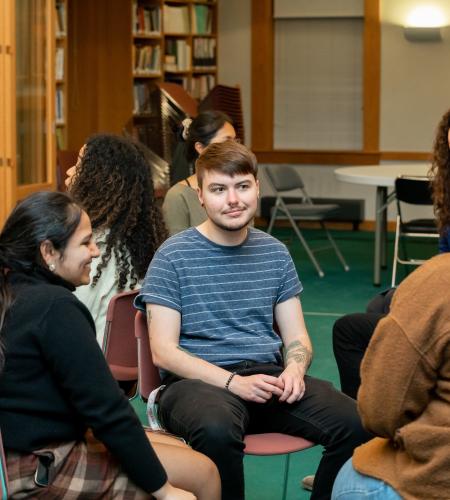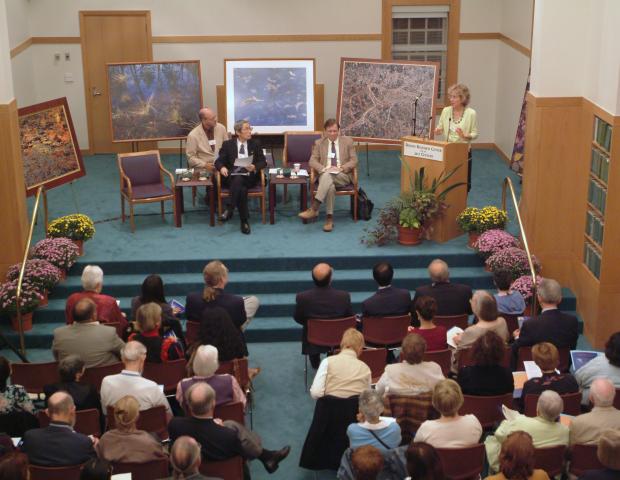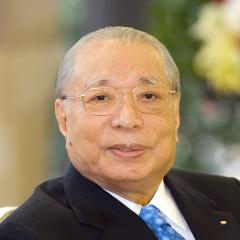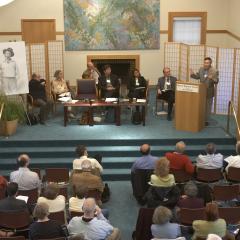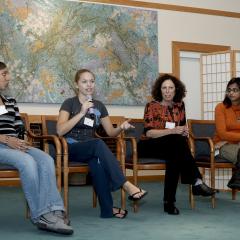Here I would like to focus on four points that I believe express core areas of confluence between these two philosophical traditions:
The first is a respect for human dignity, a reverence for the mystery and sanctity of life. Both discover limitless possibility and the ultimate value in life itself. Both express belief that all life is endowed with an inherent dignity, that life in all its manifestations is unique, irreplaceable, and worthy of respect.
Based on the spirit of the Lotus Sutra, which I believe represents the very quintessence of Eastern philosophy, the SGI today is engaged in endeavors in the fields of peace, culture, education, and human rights. The Lotus Sutra teaches that the all people possess an unsurpassed and inviolable dignity, which it terms “Buddha nature.” According to the sutra, expression and manifestation of one’s Buddha nature is life’s most fundamental goal.
Active in 13th-century Japan, Nichiren clarified the core message of the Lotus Sutra and offered a concrete means by which people could bring forth and make manifest their inherent inner dignity.
In their time, Emerson and Thoreau saw indwelling within humanity the divine and declared this to be the basis of human dignity. The “self” of Emerson’s self-reliance is a spirituality that is fully unified and harmonized with the Over-Soul, the One. As such it is fully imbued with divinity. Likewise, Thoreau’s experiment in putting into practice the spirit of self-reliance at Walden Pond, where he lived a philosopher’s life, was based on a sense of the divinity inherent in all things. Thoreau discovered and disclosed religious experience within and through his experience of nature.
A second point of commonality between Transcendentalism and Nichiren Buddhism is the idea that all things coexist within a context of mutually supportive interdependence. The chapter from the Lotus Sutra whose English translation Thoreau published in the Dial, was the “Parable of the Medicinal Herbs.” Significantly, this chapter describes “the three grasses and two types of trees” as it proudly proclaims a spirit of impartial compassion nurturing all living things in their manifold diversity. To quote a recent translation of the sutra: “Though all these plants and trees grow in the same earth and are moistened by the same rain, each has its differences and particulars.”
In the context of this sutra, the earth and rain indicate the impartial teachings and dharma of Shakyamuni; the plants and trees are like people of unique and varying capacities. This passage can also be read as portraying a world of creative coexistence, where all life-forms, fostered by the compassionate and creative power of the cosmos, receive life and exhibit their unique and particular qualities within a web of interconnection.
This vision of coexistence corresponds beautifully with Thoreau’s intuitive grasp of the harmonious mutuality with which all living things support each other and thrive.
It is likewise possible to interpret the plants and trees portrayed in the Lotus Sutra as symbolic of diverse cultures, which are supported by and draw energy from rain and earth representing the eternal principle of the universe. This is a vision of a “culture of peace”—to use a contemporary phrase—in which various cultures coexist peacefully on Earth, each demonstrating its special qualities and making its unique contribution to our greater richness.
The third point of convergence is what might be called a commitment to human-focused education—education of, by, and for human beings. When I first spoke at Harvard University, I made reference to the ideas of Emerson and expressed my sense that nothing is more needed in our world today than an inner-motivated spirit of autonomy and self-mastery. This expresses itself in the world as “soft power” issuing from the vast creative energy residing in the depths of human life.
Experience has shown us that unless ordinary citizens develop their wisdom, they too easily fall prey to the machinations of those who would abuse their power. It is from this that the need for humanistic education arises, the kind of education that enables people to transform themselves and, through that transformation, to change their societies.
In our discourse, Dr. Myerson has noted that the transcendentalists believed that institutions that had changed for the worse could only be reformed by self-motivated, right-thinking people, and not by violence.
Since its founding by the educator Tsunesaburo Makiguchi, and later under the leadership of the second president, Josei Toda, the Soka Gakkai has maintained a consistent focus on humanistic education. At the deepest level, this expresses the desire to enable all members of society to manifest their inherent Buddha nature, to develop and unleash the powers of self-motivation.
As heir to a dream of humanistic education open to all people based on the ideals of value-creating education formulated by founding president Makiguchi, I have worked to make such education a reality by establishing an international educational system from the kindergarten to the university levels.
Dr. Myerson also comments that the transcendentalists recognized the need for people to educate themselves; for citizens to engage in self-education guided not by external goals and motives, but by inner ones. He also notes the extent to which the transcendentalists were involved in various educational projects, from nursery and elementary schools to colleges and universities. They likewise saw public speaking and lectures as a necessary and effective means of educating people. They were aware of the importance of publishing in order to reach the widest possible readership.
The Soka Gakkai International has been motivated by a similar awareness. Numerous books and periodicals are published by SGI organizations worldwide in many different languages. This reflects appreciation of the essential need to involve a wide-ranging spectrum of people and to assure that popular movements are thoroughly permeated by philosophy and energy.
The stress placed by many transcendentalists on humanistic education, rooted in the eternal, that unleashes the untapped inner capacities of people finds, I believe, parallels, both at the level of ideas and of practice, in contemporary efforts of the SGI to promote humanistic education.
Finally, the fourth key area of convergence between the ideas of the American Renaissance and Nichiren Buddhism is to be found in the understanding of the connection between reform of the self and reform of society.
When he visited Soka University in Japan, Dr. Ronald A. Bosco shared this thought: “The most valuable lesson that Thoreau delivers to us today is that all cultural transformation begins with the individual, begins from within.”
For Emerson and Thoreau, any thought of reforming society is based in a philosophy of self-transformation. Emerson stressed that reform must begin from humans themselves, from the inner realm of the human heart. Efforts to improve systems or surroundings will be meaningless unless there is an inner change within people themselves.
In “Civil Disobedience” Thoreau states, “There will never be a really free and enlightened State, until the State comes to recognize the individual as a higher and independent power, from which all its own power and authority is derive, and treats him accordingly.”
Thoreau’s belief that no government can be justified in threatening human dignity finds an echo in Nichiren’s experience in 13th century Japan. In the midst of life-threatening persecutions by national authorities, he wrote: “Even if it seems that, because I was born in the ruler’s domain, I follow him in my actions, I will never follow him in my heart.”
I would note in passing that this statement was included in the UNESCO publication The Birthright of Man, published in 1969 to commemorate the 20th anniversary of the Universal Declaration of Human Rights.
When Thoreau was jailed for refusing to pay the poll tax in Concord as an act of resistance against slavery, he did not retreat in fear. Rather, the flames of the spirit of resistance rose brighter and higher. As he stated with courage and clarity: “Under a government which imprisons any unjustly, the true place for a just man is also a prison.”
In the same way, Nichiren was thoroughly committed to nonviolence, challenging the political authorities of his day solely through the spiritual power of language and words. He was completely unswayed by persecutions leveled at him by unjust and violent authorities. As he stated, “Regard meeting obstacles as true peace and comfort.”
The founding and second presidents of the Soka Gakkai, Tsunesaburo Makiguchi and Josei Toda, as heirs to the spirit of Nichiren, were likewise unbending in their resolve when they were imprisoned during World War II by Japanese authorities who sought to crush and destroy freedom of conscience.
The way of life pursued by Emerson and Thoreau—of realizing societal change through an inner reformation—find parallels in the ideas and actions of Nichiren, and in the movement by which the SGI has sought to implement social change. And this parallelism is to be found on both the spiritual dimension as well as in the concrete direction of engaged Buddhism.
In this way, the philosophies of the Transcendentalists and that of Nichiren resonate in multiple dimensions, in particular their focus on the inner depths of humanity and on our intimacy with the living cosmos.
For humanity in the 21st century, our greatest challenge is to transform the energy of division and hatred that now erupts as armed conflict and terrorism—as well as in environmental destruction—into the energy of union and harmony.
Here we can look to the inspiring example of Emerson and Thoreau, who absorbed the finest essence of Eastern thought, incarnating it as they gave rise to the American Renaissance. In this same way, I am confident that this forum will have a truly historic significance as a milestone in the effort to re-awaken East-West connections. And it is my heartfelt hope that this will contribute to a new global civilization and renaissance of life.
